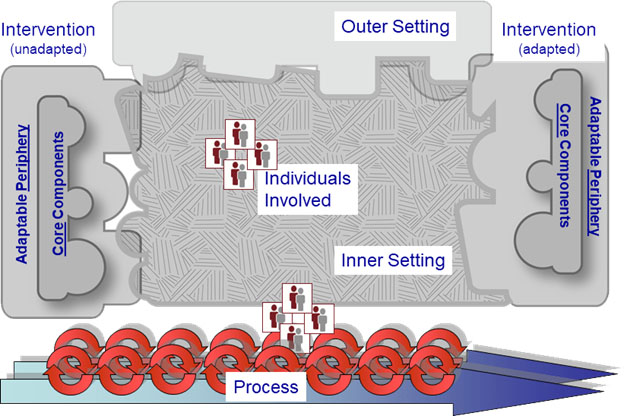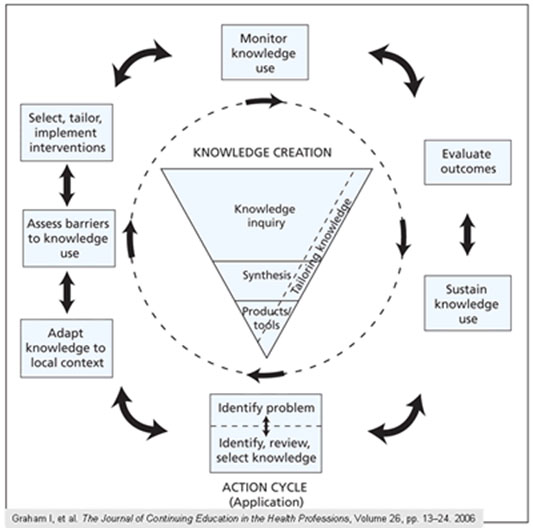Online Course
NDNP 810 - DNP Project Identification
Mod 3: Planning
Frameworks
DNP students are required to include a QI or Implementation Science frameworks for their DNP project proposals. Use of a middle-range practice theory is optional.
A framework consists of more loosely structured arrangements of theoretical constructs (often without specifying relationships among them) or prescriptive approaches for implementation. A framework specifies the steps or phases to execute for reaching implementation goals. It describes the factors that may influence outcomes.
Implementation frameworks can be broken down into three major types: 1) determinant framework, 2) evaluation framework, and 3) process framework (Damschroder et al., 2009). Framework are broken into these categories based on how the frameworks will be used. Some framework do not fit neatly into one of these three categories. A few examples of frameworks that are based on a compilation of multiple implementation research studies are:
- Framework for Complex Implemenation – a process framework
- Consolidated Framework for Implementation Research – an evaluation framework
- Promoting Action on Research Implementation in Health Services (PARIHS) – a process framework
- Knowledge to Action – a process framework
Framework of Complex Innovation Implementation

Source: Helfrich, C.D., Weiner, B.J., McKinney, M.M. & Minasian. L. (2007). Determinants of implementation effectiveness adapting a framework for complex innovations. Medical Care Research and Review, 64(3), 279-303 doi: 10.1177/1077558707299887
Consolidated Framework For Implementation Research
The CFIR provides a menu of constructs that have been associated with effective implementation. It reflects the state-of-the-science at the time of its development in 2009; including constructs from, for example, Everett Rogers’ Diffusion of Innovations Theory and Greenhalgh and colleagues’ significant compilation of constructs based on their review of 500 published sources across 13 scientific disciplines. In addition to these two sources, the CFIR incorporates 18 other sources. The CFIR considered the spectrum of construct terminology and definitions and compiled them into one organizing framework.

The CFIR was developed by implementation researchers affiliated with Veterans Affairs (VA) Diabetes Quality Enhancement Research Initiative (QUERI). The VA QUERI was launched in 1998 as part of a system-wide transformation aimed at improving the quality of healthcare for Veterans and continues to contribute to this effort by implementing research findings and innovations into routine clinical practice.
https://www.youtube.com/watch?v=tPCJWA7mVjk
Knowledge To Action
Identification of problems and their articulation into questions that can be answered through known scientific methods lies at the heart of problem-solving in health care. For some problems, the solutions may be already available in existing knowledge sources (published research literature, guidelines, etc.), while for others, new solutions will need to be found through appropriate research.
In the context of health care, experience shows that implementation of research-based knowledge in real life is complex and riddled with barriers. Therefore, available research data need to be synthesized and the resulting knowledge contextualized prior to implementation. Moreover, interventions to introduce evidence-based knowledge in practice may need to be tailored to overcome specific local barriers.
Knowledge generation and the implementation of existing and new solutions is an intricate cyclical process that has been summarized by Graham et al. as the "Knowledge-to-Action" Framework (See figure below).

https://www.youtube.com/watch?v=191HOdZ1SHo
PARiHS
PARiHS (Promoting Action on Research Implementation in Health Services) emerged from the observation that successful implementation in health care might be premised on three key determinants (characteristics of the evidence, context and facilitation). PARIHS has subsequently undergone substantial research and development work and has been widely applied.
The PARiHS (Promoting Action on Research Implementation in Health Services) Framework provides a way to implement research into practice. With case studies of teams implementing evidence, it examines the interactions between three key elements for knowledge translation. Three factors determine research use:
Evidence, Context, Facilitation
Significantly, this framework argues that successful implementation (SI) of evidence into practice had as much to do with the context or setting where the new evidence was being introduced and how that new evidence was introduced (facilitated into practice) as it had to do with the quality of the evidence

Kitson et al, 2008
https://www.youtube.com/watch?v=YBdztomiOQI
(This presentation contains information on KTA, CFIR as well as PARiSH Framework)
DNP students will be using the QI Process MAP-IT model, and students are required to use a QI or Implementation Science framework that best fits their project.
References:
- Damschroder, L.J., Aron, D.C., Keith, R.E., Kirsh, S.R., Alexander, J.A., & Lowery, J.C. (2009). Fostering implementation of health services research findings into practice: A consolidated framework for advancing implementation science. Implementation Science, 4(50), doi:10.1186/1748-5908-4-50
- White, K.M. (2021).The science of translation and major framework in White, K.M., Dudley-Brown, S., & Terhaar, M.F. Translation of Evidence into Nursing and Healthcare (pp. 27-58) New York: Springer Publishing Company.
- Helfrich, C.D., Weiner, B.J., McKinney, M.M. & Minasian. L. (2007). Determinants of implementation effectiveness adapting a framework for complex innovations. Medical Care Research and Review, 64(3), 279-303 doi: 10.1177/107755870729988
This website is maintained by the University of Maryland School of Nursing (UMSON) Office of Learning Technologies. The UMSON logo and all other contents of this website are the sole propEvidence Reviewy of UMSON and may not be used for any purpose without prior written consent. Links to other websites do not constitute or imply an endorsement of those sites, their content, or their products and services. Please send comments, corrections, and link improvements to nrsonline@umaryland.edu.